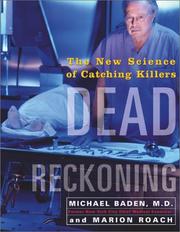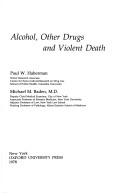| Listing 1 - 5 of 5 |
Sort by
|

ISBN: 0684867583 9780684867588 Year: 2001 Publisher: New York: Simon & Schuster,
Abstract | Keywords | Export | Availability | Bookmark
 Loading...
Loading...Choose an application
- Reference Manager
- EndNote
- RefWorks (Direct export to RefWorks)
Visit a class where students blow mouthfuls of their own blood onto one another in order to better understand blood spatter patterns. Attend a workshop studying the effects of temperature and humidity on the life cycle of maggots populating a corpse. Learn how much of someone’s history of drug use can be detected in a single strand of hair. Wander the aisles at the annual conference of the American Academy of Forensic Sciences, where booths display the latest in body bags and where the giveaway of choice is an ergonomic squeeze toy in the shape of a human kidney. Forensic science used to be a specialized field virtually unknown to the general public. In recent years, news reports of crimes solved through the analysis of DNA evidence have given everyone a glimpse of this astonishing field. But behind the crime scene tape and the doors of the morgue is a world never seen by the public. Now famed pathologist and medical examiner Dr. Michael Baden and award winning writer Marion Roach take readers on a tour of sites otherwise closed to visitors. In his forty year career, Dr. Baden has conducted more than 20,000 autopsies and has consulted on numerous high profile cases, including the assassination of John F. Kennedy and the Nicole Brown Simpson Ron Goldman murders. In Dead Reckoning, the authors take readers into the laboratory, to the autopsy table, onto the witness stand and out in the field to show how advances in forensic science can solve the crucial questions in a criminal case, often with startling accuracy. Dead Reckoning examines cases both famous and little known to explain why the first hours at a crime scene are crucial. Baden and Roach reveal, for example, how a key clue to the killer of Nicole Brown Simpson was lost when her body was moved to the morgue, and why the JonBenet Ramsey case can never be solved. They show how no clue is too small to be analyzed; in one homicide case, the imprint of a button on the victim’s skin was overlooked until months later when, while reviewing crime scene photos, Dr. Baden saw it, causing the case to take an astonishing turn. In another case, the presence of certain insects on a body helped to pinpoint the time of death and discredit the killer’s alibi. Even crimes that took place decades earlier can be reexamined, as in the case of Medgar Evers’s assassination or the murders of the Romanovs in Russia. Ultimately, however, the new tools of forensic science are only as incisive as those who use them, which is why forensic pathology is in many ways as much an art as it is a science.’The fact is that we die as we live,’ Baden says. ‘This is especially true when death is due to unnatural causes… All can be read at death like a biography.’ Full of the behind the scenes drama that only cops, prosecutors, and medical examiners usually see, Dead Reckoning is a fascinating look at how forensic science is changing forever the way we convict the guilty and free the innocent.
Homicide investigation --- Medical examiners (Law) --- Forensic sciences --- Forensic pathology --- Crime laboratories --- Crime scenes

ISBN: 0195023595 Year: 1978 Publisher: New York (N.Y.) : Oxford university press,
Abstract | Keywords | Export | Availability | Bookmark
 Loading...
Loading...Choose an application
- Reference Manager
- EndNote
- RefWorks (Direct export to RefWorks)
Ethics and addiction --- Social problems --- Criminology. Victimology --- Toxicology --- Alcoholism --- Death --- Drug abuse --- Violent deaths --- Accidents. --- Alcoholism. --- Drug abuse. --- Homicide. --- Violence. --- Causes.
Book
Year: 1968 Publisher: Philadelphia (Pa.) : Lippincott,
Abstract | Keywords | Export | Availability | Bookmark
 Loading...
Loading...Choose an application
- Reference Manager
- EndNote
- RefWorks (Direct export to RefWorks)
Book
ISBN: 0394569822 Year: 1989 Publisher: New York (N.Y.): Random House
Abstract | Keywords | Export | Availability | Bookmark
 Loading...
Loading...Choose an application
- Reference Manager
- EndNote
- RefWorks (Direct export to RefWorks)
Book
ISBN: 0397580266 9780397580262 Year: 1975 Publisher: Philadelphia J.B. Lippincott
Abstract | Keywords | Export | Availability | Bookmark
 Loading...
Loading...Choose an application
- Reference Manager
- EndNote
- RefWorks (Direct export to RefWorks)
| Listing 1 - 5 of 5 |
Sort by
|

 Search
Search Feedback
Feedback About UniCat
About UniCat  Help
Help News
News